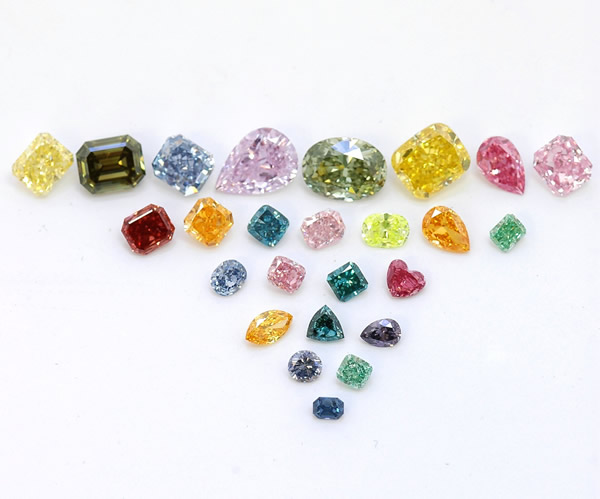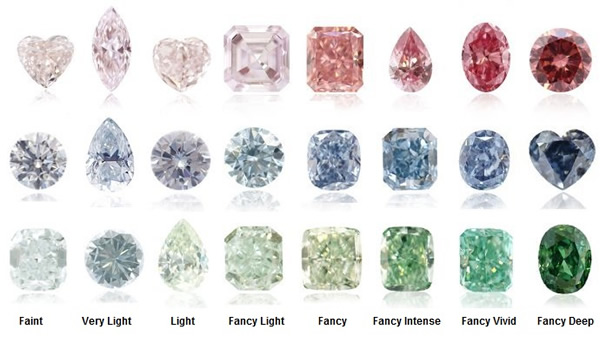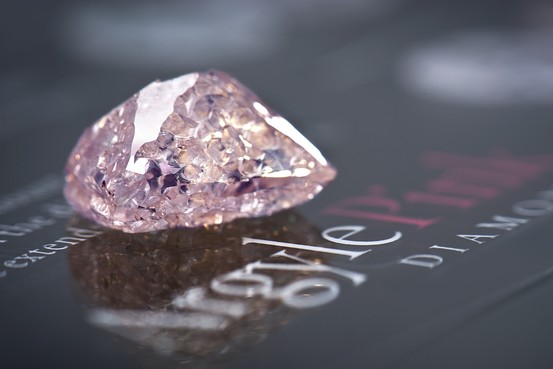While the majority of diamonds appear colorless or have only a slight yellow tint, the world’s most famous diamonds — among them, the blue Hope diamond and the Moussaieff red diamond — are colored, Charlotte McLeod says in an article posted on resourceinvestingnews.com.
These colored diamonds make up just 2 percent of all diamonds and regularly fetch higher prices than those that are colorless.
But how do colored diamonds compare to their less flashy counterparts? And should investors look to them as a sound investment?
Why are diamonds different colors?
Diamonds can be virtually any color, including yellow, brown, pink, red, blue, green, grey, violet, orange and black. Both colorless and colored diamonds are formed through the same basic process: the crystallization of highly pressurized carbon molecules.
However, when trace elements are trapped during this process, the resulting diamond is colored. For example, yellow diamonds are caused by the entrapment of nitrogen. This concept helps explain why diamonds of the same color tend to be found together; if soil is rich in a particular element, that element is likely to make its way into diamonds as they are forming.
In addition, some colored diamonds, such as green diamonds, are the result of natural radiation, while others, like red, brown and pink diamonds, are the result of structural irregularities caused by higher pressure during formation. Diamond cut and fluorescence, the light a diamond emits after absorbing light or other electromagnetic radiation, also have a minor impact on color.
Type I and type II diamonds
As mentioned, most diamonds are either colorless or have a yellow tint, which means they contain nitrogen. These diamonds are categorized as type I and are subdivided into types IaAB, IaA, IaB and Ib.
Colored diamonds contain almost no nitrogen and are classified as type II diamonds. The type II category also includes subdivisions: IIa and IIb. Type IIa diamonds can be colorless, brown or pink and, as they are made almost wholly of carbon, are the purest type of diamond. Type IIb diamonds contain boron, but otherwise are made entirely of carbon; these diamonds are blue.

Grading diamond colors
Most diamond-grading labs use the Gem Institute of America’s (GIA) color-grading scale to assess the color of type I diamonds, which are considered to be in the “normal” color range. On the GIA’s scale, these diamonds are assigned a letter from D to Z, with D being colorless and Z being light yellow or brown; diamonds with a D rating are the rarest and the most valuable. Some diamond retailers do not carry the lower grades as there is not enough demand for them.
However, colored diamonds — also known as “fancy-colored” diamonds — fall outside the GIA’s grading scale. Instead, these diamonds are graded “by measuring hue, saturation, light to dark tone (value), and the diamond’s uniformity of color distribution” and are given a description rather than a letter. Unlike regular diamonds, for which carat weight, clarity, color and cut (the 4Cs) are equally important, color is the most important characteristic for these diamonds.

Hue, saturation and tone all relate to color. Hue refers to the color of the diamond, tone is a measure of the lightness or darkness of the color and saturation describes the color’s intensity.
With all of these factors to consider, grading fancy-colored diamonds is perhaps even trickier than grading regular diamonds, particularly as characteristics like hue are not always easy to define. For example, a diamond might be bluish green, not simply blue or green.
Further, there are six categories of saturation: fancy light, fancy, fancy intense, fancy dark, fancy deep and fancy vivid. Some diamond retailers, like Leibish & Co., further break down these categories by assigning fancy-colored diamonds a grade range on a scale of one to 10, with one indicating weak color and 10 designating strong color. Using this system, a diamond might be classified as fancy orange with a grade of eight to 10, meaning that it is closer to fancy intense than fancy light.
In the case of both regular and fancy-colored diamonds, classification is based on comparison to a set of “masterstones,” each of which represents a particular color description or letter on the GIA scale. As diamond grading is somewhat subjective, diamonds are usually examined by several different people.
Investing in colored diamonds
The diamond industry is currently suffering from both weak demand and tight margins, but the long-term outlook for the sector is widely agreed to be positive. Colored diamonds are no exception.
In fact, Leibish Polnauer, president and founder of Leibish & Co., told Forbes earlier this year that in the last decade the value of colored diamonds has increased considerably more than that of other investments. Polnauer noted “that a five-carat fancy yellow diamond increased in value by 180 percent from 2001 to 2011,” while Berkshire Hathaway (NYSE:BRK.A) stock “increased by 52 percent for that 10-year period” and Coca-Cola (NYSE:KO) “grew 42.5 percent.”
In an interview with Diamond Investing News, Ziad Al-Ahmadi of Matrix Diamond Technology, an Antwerp-based company that focuses on analyzing, manufacturing and realizing rough diamonds, corroborated Polnauer’s views — to an extent. While Al-Ahmadi noted that there are now fewer fancy-colored diamonds coming out of the ground and hardly any new mines coming online, both of which have led to substantial increases in prices for fancy-colored diamonds over the past 10 years, he stressed that the circulation of polished diamonds must also be taken into account. That is, investors must keep in mind that even as nature is producing fewer of these diamonds, there is nothing to stop polished fancy-colored diamonds from re-entering the market — for example, upon inheriting a diamond, one might opt to sell that diamond.
While of course nothing is certain, simple supply and demand fundamentals suggest that for the time being, Polnauer’s prediction will prove correct. Colored diamonds are growing more and more popular as supply decreases and an increasing number of major market players turn away from the diamond business on concerns that the sector is too small; Harry Winston (TSX:HW,NYSE:HWD) recently agreed to pay BHP Billiton (NYSE:BHP,ASX:BHP,LSE:BLT) $500 million for its 80-percent stake in the Ekati diamond mine and rumor has it that Rio Tinto (ASX:RIO,NYSE:RIO,LSE:RIO) is thinking along the same lines. Those factors, coupled with the fact that there is no sure way of predicting when existing polished fancy-colored diamonds will come up for sale, indicate that now is a prime time for investors to get involved.
What companies are mining colored diamonds?
When asked where fancy-colored diamonds can be found, Al-Ahmadi noted that the majority are mined in three main regions: Australia, Russia and South Africa. He also highlighted several companies that are doing significant work in those areas.
Rio Tinto describes itself as the “world’s leading provider of natural colour diamonds” and its Australia-based Argyle mine is the world’s largest source of colored diamonds, specifically champagne, cognac and pink diamonds, which enjoy wide popularity. Earlier this year, the company announced the discovery of Australia’s largest pink rough diamond at Argyle; while the value of the 12.76-carat diamond was reduced by the discovery of internal flaws during polishing, it remains an important discovery. Argyle is expected to remain in operation until at least 2019.

Russia’s Alrosa holds a monopoly over Russian diamond mining and in terms of value accounts for 25 percent of the world’s diamond production. It is a major player in the diamond market and recently signed a long-term agreement worth at least $60 million to supply rough diamonds to a Tiffany & Co. subsidiary. The company’s website notes that when it finds diamonds with “a rare unique color in combination with high clarity, or unique inclusions, or crystallographic outlines” it has to present them to a Russian Ministry of Finance committee.
Lucara Diamond (TSX:LUC,NASDAQ:LUC) is a new diamond producer that wholly owns the Botswana-based Karowe mine and holds a 75-percent interest in the Mothae project, located in Lesotho, a landlocked country that is completely surrounded by South Africa. Both are large-scale assets that have “consistently included large, Type IIA stones,” according to the company’s website. At the beginning of November, Lucara announced the recovery of a 9.46-carat type II blue diamond from the Karowe mine. The diamond was sold less than a month later for $4.5 million. Al-Ahmadi placed particular emphasis on the importance of the discovery, commenting that the average 10-carat diamond sells for “no more than $100,000.”
